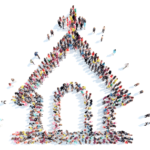I recently interviewed someone for research who said, “You know, there are scars that have healed, and then there are scars that are still open.” I have thought about those insightful words a lot.
Scars of the Civil Rights Movement
January gives us the opportunity to celebrate the life and ministry of Dr. Martin Luther King Jr. Through the celebration and remembrance of his life, we also remember the events that brought about the integration of our schools, workplaces, restaurants and countless other points of change. Such change indicated to America that we no longer were going to tolerate racism and the division resulting in a lack of equitable treatment of and opportunity for everyone. Instead, we were going to work for equitable treatment of and opportunity for everyone regardless of race, ethnicity and gender.
As these changes took place, countless people were treated inhumanely, all in the name of change. Many of our nation’s leaders were killed for the views and the values they held.
King was such a central leader in the Civil Rights Movement and, because of his desire for people to experience being treated with basic honor, dignity and respect, paid the ultimate price of his life being taken unexpectedly and violently.
I don’t know about you, but this is a painful history to recall. It is a history and context that God used to sensitize me to justice-centered ministry and relationships. It is this history that showed me how horrible people can be in their treatment of anyone who is considered different—regardless of the reason.
I am so grateful that my life is full and rich because it is full of individuals, families and communities that represent the inclusion of all people.
Scars from childhood experiences
When I was a kid, I wanted a bicycle so badly and knew I probably wouldn’t get one. I kept asking for a bicycle, though.
I wanted to have the kind of bicycle my mother had in England. It was a Raleigh bike, made in England and sold in the United States. The brakes were on the handlebars, and the bike was totally skinny and not thick like the Schwinn bikes my brother had. What possibly could be better for a little girl than to have an English racer bicycle?
Christmas came, and oh, I was so disappointed not to get that bicycle!
Sign up for our weekly edition and get all our headlines in your inbox on Thursdays
Saphonia was my best friend as a kid. She lived around the corner from me. We went to the same school—Lincoln Elementary—were in the same class, and always walked back and forth to school together. We played together whenever we could and did all the things kids do. After all, Saphonia was my best friend!
Was I ever surprised when my parents gave me that English racer bicycle … for my birthday!
I was so happy that—yes, you guessed it—I wanted to show my new bike to my best friend, Saphonia. I wanted her to be able to ride it and to enjoy it along with me.
My mother said as I left my house: “Remember you aren’t used to using the handbrakes yet. When you make the turn at the end of the street, remember you will leave our street made of concrete and that Saphonia lives on a street made of gravel. If you don’t remember that, you will fall and hurt yourself and your new bicycle.”
“I know mother,” I replied.
As usual, my mother’s caution to me was right on target. As I made the turn onto the gravel road—my mind totally on sharing with Saphonia my new bike and letting her ride it—I forgot about the handbrakes. I wasn’t on that brand new bike very long.
When Saphonia and her mother picked me up from that gravel street, my knee was full of gravel. I was hurt. On top of that, my beautiful new bike also was hurt.
My good friend, Saphonia, didn’t get to ride my new bike because it was all bent up. Because I had gravel in my knee, I couldn’t walk easily. With all of these things together, I cried and cried.
It was one of those times I was reminded clearly to pay attention to what I was doing and not to get distracted.
Being people who help ‘the scars to heal’
“There are some scars that have healed. There are some scars that are still open.”
It took a while, but my knee finally was cleared of all the gravel lodged there. Talk about painful. To have my knee cleaned out on a daily basis for several months was quite an ordeal for a little girl.
You may be wondering if I have scars from that event. I do have three distinct scars on my right knee. They are healed and have been for quite some time, but they are a part of me and are not going away. “There are some scars that have healed.”
During January, we emphasize in various celebratory ways the changes in our lives and in our country showing “there are some scars that have healed.” We remember the deeply spiritual and insightful letters, sermons, speeches and words of a man who was given a vision from God about what a society would look like and be like that didn’t base actions toward others on the basis of skin color, age, gender and so much more.
What about those “scars that are still open?” We hear of them daily. They are brutal, and most show the worst side of humanity.
The “scars that are still open” give us countless opportunities to be the loving people God has created us to be.
My constant prayer is that we would be people who help “the scars to heal.”
Gaynor Yancey is a professor in Baylor University’s Diana R. Garland School of Social Work and Truett Seminary and director of the Center for Church and Community Impact. She is a member of First Woodway Baptist Church in Waco. The views expressed are solely those of the author.














We seek to connect God’s story and God’s people around the world. To learn more about God’s story, click here.
Send comments and feedback to Eric Black, our editor. For comments to be published, please specify “letter to the editor.” Maximum length for publication is 300 words.